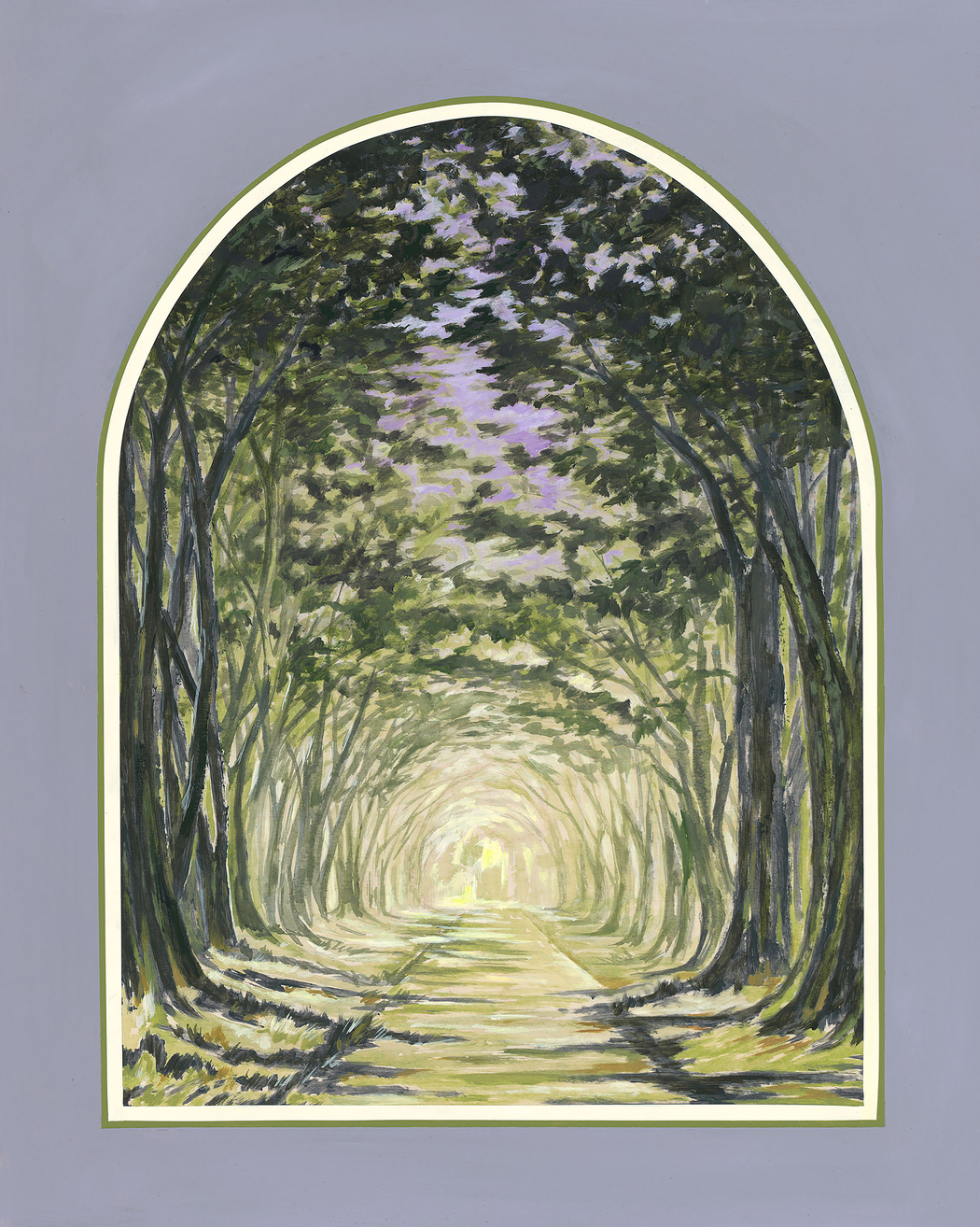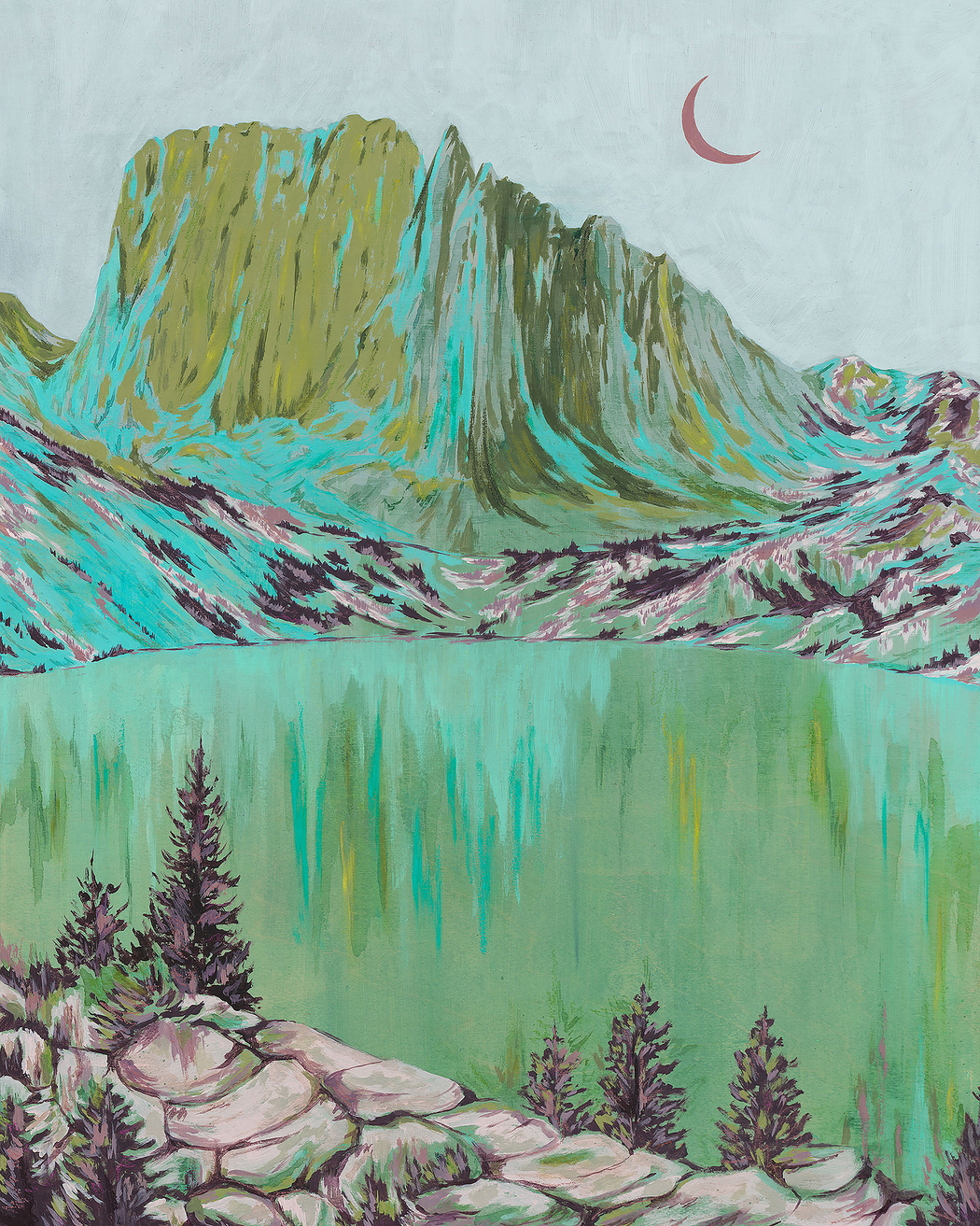Jennifer Peart
Year of birth: 1987
Where do you live: Sacramento, CA
Your education: BA Studio Art, Mills College, Oakland, CA
Describe your art in three words: Visionary Landscape Paintings
Your discipline: Painting
Website | Instagram

Your work blends natural landscapes with graphic motifs and architectural elements. How do you approach the fusion of these seemingly different aspects in your paintings?
I see Earth’s landscapes as living archives, layered with both human and ecological histories. In my work, I merge organic forms with structured, architectural elements, drawing inspiration from science fiction and retrofuturistic design to create visionary landscapes. Influenced by visionary fiction writers, I imagine worlds where built environments and natural systems exist in deep reciprocity. Portals, arches, and celestial motifs appear throughout my compositions as gateways to speculative futures – landscapes that feel both familiar and reimagined. These structures aren’t imposed upon the land but emerge as part of its evolving story, suggesting thresholds between past and future, the earthly and the celestial, the seen and the possible.
The themes of balance, coexistence, and renewal are evident in your work. Could you elaborate on how these ideas inform your creative process?
I think about painting as a way to navigate relationships – the relationships between past and future, structure and wildness, decay and regeneration. My compositions often explore balance as a conversation between architectural elements and nature. I’m inspired by restoration and renewal, by the idea that landscapes are always in flux, shaped by both human imagination and nature’s resilience. This manifests in my work as graphic motifs or planetary echoes embedded in thriving ecosystems, as well as built structures dissolving into lush forests. I believe that renewal is always possible. Our ingenuity and science-fueled imaginations can be harnessed to reclaim our roles as stewards of this extraordinary planet. We must re-remember that we are not separate from nature, but active participants in its unfolding story.
 Jennifer Peart | Where Trees Touch Sky | 2024
Jennifer Peart | Where Trees Touch Sky | 2024
Your paintings are described as “portals of possibility.” How do you envision the future through your art, and what kind of futures do you hope to convey to your audience?
I paint landscapes not just as they are, but as they could be. My work is a way of asking: What if we designed human infrastructure with deep reciprocity in mind? What if our built spaces honored and amplified the natural world instead of fragmenting it? I draw inspiration from science fiction, modern architecture, social activists’ radical imagination, and ecological realities – visions of off-world habitats designed to preserve biodiversity, restored landscapes where past harm has been undone, urban architectural design that integrates permaculture farming, and transportation planning that includes wild animal and insect migration. Through speculative imagery, I layer possibilities and opportunities, inviting viewers to step into alternative visions of our future relationship with nature. Coexistence is not just a goal or utopian idea, but a return to a cultural practice. Indigenous peoples across the globe are the original stewards of this knowledge, having lived in balance with their environments for millennia. By reimagining our relationship with the land, my paintings offer a hopeful glimpse into futures where human innovation and ecological wisdom work in harmony rather than opposition.
How does your connection to nature influence your work? Are there specific natural landscapes or moments that inspire you in your creative journey?
My relationship with nature is at the core of my practice. I don’t see myself as separate from the land I walk on and the water I swim in. When I’m in nature, preferably by a flowing body of water, I feel most whole, most in sync with the universe. I grew up in the rural Sierra Nevada foothills of Northern California, where my family camped and hiked often, and those early experiences shaped my understanding of place. I have an early memory of drawing on a granite rock face with a charred stick and watching the rain wash it away. That imagery echoes in how I approach painting – as something both deeply sacred yet impermanent. Now, I seek out landscapes that hold layered histories – places where human presence and natural forces are entwined, where fate is at a tipping point, where past and future overlap.
 Jennifer Peart | Pine Lake Prism | 2024
Jennifer Peart | Pine Lake Prism | 2024
Can you discuss how mid-century modern architecture and design have influenced your work, and how you integrate these references into your landscapes?
Mid-century modern and atomic-era design have always fascinated me – the clean lines, balanced color schemes, and the era’s optimistic embrace of the future. There’s a deep sense of hope embedded in the aesthetic, a belief that visual arts and architecture could shape the world or at least transform how we feel about it. Artists, architects, and designers of the time saw creativity as a means of progress, using form, color, and space to inspire a sense of possibility. In my paintings, I reference this optimism through geometric overlays, floating planes, color choices, and structural elements that echo modernist forms. But I also push these references into a speculative space, imagining how design might evolve in future landscapes – how it could become more adaptive, more symbiotic with nature, carrying that same spirit of hope into new, yet-to-be-imagined worlds.
What role do color palettes and spatial inversions play in your paintings? How do they contribute to the overall narrative of your pieces?
Color is a tool for both emotion and world-building in my work. I often use heightened or unexpected palettes to shift perception – to suggest that these landscapes exist in a liminal space, somewhere between memory and possibility. I love my avocado and olive greens. Muted pinks or dusty roses are other favorites. But mostly, it’s the interplay of unexpected colors that really pleases me. The spatial inversions, like flipping sky and ground or inserting translucent geometric shapes, are a way of reorienting the viewer, inviting them to step outside conventional perspectives. These techniques allude to the fluidity between past and future, natural and built, seen and unseen. They create invitations. Other times, they add a sense of movement – of landscapes that are alive and in transition, much like the real ecosystems I use as subject matter.
Your works seem to have a futuristic and speculative quality. How do science fiction and your interpretation of alternative realities inform your visual language?
Science fiction – particularly visionary fiction – expands the imagination, blending science, spirituality, and radical possibility to explore how we might shape a more just, interconnected future. It challenges us to imagine what’s possible when we approach our present challenges with creativity, collaboration, and innovation. Rather than just depicting dystopias or idealized utopias, visionary fiction explores the evolving relationships between technology, nature, and society.
My paintings are deeply influenced by my reading habits. I read and re-read the works of Octavia Butler and Ursula K. Le Guin. Their ideas and world-building help me create paintings that aren’t just about beautiful places or escapist worlds, but about hope – about asking, What if we designed a future where coexistence with nature is the norm? My love for these books, as well as fandoms like Star Trek and tabletop games such as Dungeons & Dragons, fuels my dreams for the world I will one day leave behind. My future visions are not perfect, but they are intentionally more attuned to the well-being of a living planet.

Leave a Reply